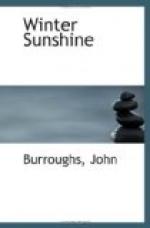In March that brief summary of a bear, the raccoon, comes out of his den in the ledges, and leaves his sharp digitigrade track upon the snow,—traveling not unfrequently in pairs,—a lean, hungry couple, bent on pillage and plunder. They have an unenviable time of it,—feasting in the summer and fall, hibernating in winter, and starving in spring. In April I have found the young of the previous year creeping around the fields, so reduced by starvation as to be quite helpless, and offering no resistance to my taking them up by the tail and carrying them home.
The old ones also become very much emaciated, and come boldly up to the barn or other outbuildings in quest of food. I remember, one morning in early spring, of hearing old Cuff, the farm-dog, barking vociferously before it was yet light. When we got up we discovered him, at the foot of an ash-tree standing about thirty rods from the house, looking up at some gray objects in the leafless branches, and by his manners and his voice evincing great impatience that we were so tardy in coming to his assistance. Arrived on the spot, we saw in the tree a coon of unusual size. One bold climber proposed to go up and shake him down. This was what old Cuff wanted, and he fairly bounded with delight as he saw his young master shinning up the tree. Approaching within eight or ten feet of the coon, he seized the branch to which it clung and shook long and fiercely. But the coon was in no danger of losing its hold, and, when the climber paused to renew his hold, it turned toward him with a growl, and showed very clearly a purpose to advance to the attack. This caused his pursuer to descend to the ground with all speed. When the coon was finally brought down with a gun, he fought the dog, which was a large, powerful animal, with great fury, returning bite for bite for some moments; and after a quarter of an hour had elapsed and his unequal antagonist had shaken him as a terrier does a rat, making his teeth meet through the small of his back, the coon still showed fight.
They are very tenacious of life, and like the badger will always whip a dog of their own size and weight. A woodchuck can bite severely, having teeth that cut like chisels, but a coon has agility and power of limb as well.
They are considered game only in the fall, or towards the close of summer, when they become fat. and their flesh sweet. At this time, cooning in the remote interior is a famous pastime. As this animal is entirely nocturnal in its habits, it is hunted only at night. A piece of corn on some remote side-hill near the mountain, or between two pieces of woods, is most apt to be frequented by them. While the corn is yet green they pull the ears down like hogs, and, tearing open the sheathing of husks, eat the tender, succulent kernels, bruising and destroying much more than they devour. Sometimes their ravages are a matter of serious concern to the farmer. But every such neighborhood has its coon-dog, and




